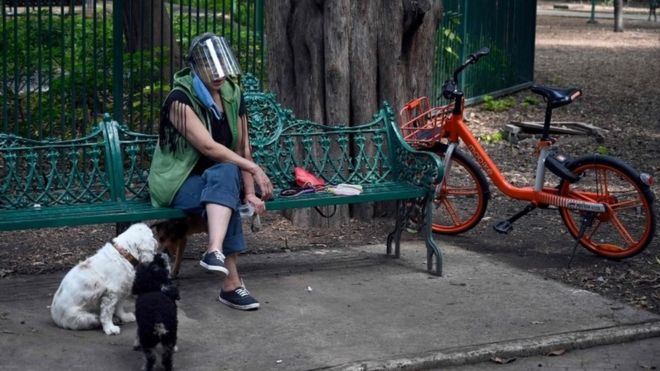Recognizing All Aspects of Viral Transmission
"The debate over whether the airborne transmission route occurs is over. Many of us have claimed its relevance from very early in this pandemic."
"It was real then. It is real now. Period."
Dr.Richard L. Corsi, dean, engineering and computer science, Portland State University
"Hand-washing and social distancing are appropriate, but in our view, insufficient to provide protection from virus-carrying respiratory microdroplets released into the air by infected people."
"[The problem is a matter of] heightened significance now, when countries are re-opening following lockdowns -- bringing people back to workplaces and students back to schools, colleges and universities."
"All routes of transmission must be interrupted [to await the arrival of a vaccine]."
Joint commentary, Journal of Clinical Infectious Diseases
"Simple things can make a big difference."
"Wear masks whenever you are not at home. Even simple homemade masks can have a major impact."
"Open windows. Don't gather in large groups inside with singing and loud talking."
Dr.Donald Milton, professor of environmental health, University of Maryland
"[Some public health officials have dismissed airborne transmission] which does not strike me as being very cautious when you are dealing with a virus which is still new and is causing a very severe pandemic."
"[Under the precautionary principle] you don't have to await scientific certainty to take extra precautions."
"It's very inconvenient to acknowledge aerosol transmission because it takes a lot more work to deal with it. Certainly not everyone who has worked with COVID patients has been infected. But there have been a very high number of health-care workers worldwide that have been."
"This is something that needs to be re-examined very carefully."
"In poorly ventilated settings you would expect aerosol transmission to increase."
"[Wearing masks is] something that vigorously should be encouraged, absolutely."
Dr.Raymond Tellier, medical microbiologist, McGill University Health Centre
 |
| The World Health Organization is preparing a scientific brief on modes of transmission that will be released in the coming days, according to Maria Van Kerkhove, technical lead on the COVID-19 pandemic at WHO (Martial |
In a shocked and traumatized world it's just as well that some concensus occurs between health scientists to advise and inform the general public, left confused by persuasive counter-arguments emanating from the authority of experts in the field of virology and infectious diseases. As has occurred most recently when a group of 239 think-alike scientists messaged an appeal to the World Health Organization along with other national health authorities to grant formal recognition to the potential for the airborne contagion of COVID-19.
Published yesterday in the Journal of Clinical Infectious Diseases, there is a warning under the signatures of an international group of scientists that every reason exists to anticipate that SARS=CoV-2 may be spread through microscopic repository droplets sufficiently small to remain aloft and capable of travelling through a room-like space, just like any other coronavirus.
Airborne transmission of COVID-19 micro particles is generally not recognized by most public health bodies, the World Health Organization included. Certain aerosol-generating medical procedures known to cause airborne transmission present as the exception. The preferred messaging is that close contact and larger respiratory droplets seen when people sneeze or cough represent the primary vector for infection, despite the limited range of one or two metres before the droplets fall.
The hundreds of agreed scientists support the explanation that there is a "real risk" in airborne transmission of COVID-19, but it does not represent the only "real risk", referring to a plausible explanation for a number of superspreading events. The possibility of airborne transmission is not under consideration by a number of public health officials. The reason for this reluctance is debatable, yet there is the very fact that not enough is yet known about the SARS-CoV-2 virus to feel confident in predicting any route it takes, now and in t he future.
However, measures have been recommended to retard airborne transmission which could include effective ventilation to ensure more clean air enters premises from the outdoors and less circulating air in public buildings, workplaces schools, hospitals and nursing homes. And that remedies can be suggested such as airborne infection controls such as germicidal UV lights and avoidance of overcrowded conditions, paying particular attention to public transport and public buildings.
Studies have noted that "beyond any reasonable doubt" tiny virus-heavy aerosolized droplets released as people exhale, talk and cough, are capable of floating in the air and drifting long distances carried by currents; possibly as wide-ranging as tens of metres in distance, according to the message from the combined opinion piece.
"Currently, health experts believe that coronavirus cannot be transmitted through airborne transmission", according tot he B.C.Centre for Disease control. Unravelling which transmission route -- droplets via close contact -- airborne? contaminated hands? represent the most important theory is difficult to support. Breathing and speaking helps to emit and transmit minuscule aerosols as a response to why it is that asymptomatic people not coughing or sneezing are able to transmit the virus.
Of primary importance it remains well understood that "In poorly ventilated settings aerosol transmissions are expected to increase." Asymptomatic individuals aren't coughing or sneezing yet are able to transmit the virus. Physical distancing and washing hands and self-isolating should someone recognize the symptoms of disease, emphasized Dr.Tellier.
"We wanted them to acknowledge the evidence."
"This is definitely not an attack on the WHO. It's a scientific debate, but we felt we needed to go public because they were refusing to hear the evidence after many conversations with them,"Jose Jimenez, chemist, University of Colorado, paper co-signer
 |
| Scientists have accused the WHO of underestimating the possibility of airborne transmission AFP |
Labels: Aerosol Droplets, Infection, Novel Coronavirus, Transmission

0 Comments:
Post a Comment
<< Home